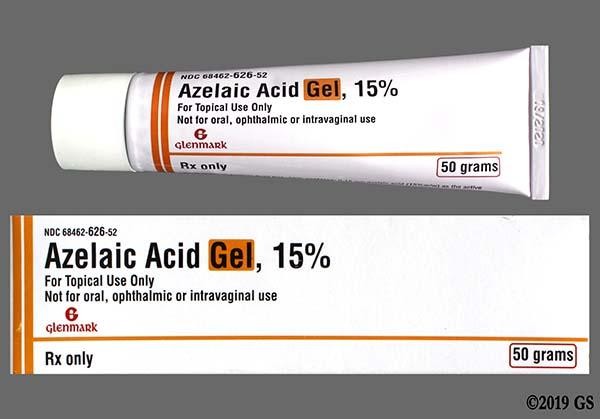
Contents
- 1 azelaic acid
- 1.0.1 Warnings
- 1.0.2 What are the side effects of azelaic acid?
- 1.0.3 What are the dosages of azelaic acid?
- 1.0.4 What drugs interact with azelaic acid?
- 1.0.5 Pregnancy and breastfeeding
- 1.0.6 Subscribe to MedicineNet’s Skin Care & Conditions Newsletter
- 1.0.7 What else should I know about azelaic acid?
- 1.0.8 From
- 1.0.9 Summary
azelaic acid
Azelaic acid is an acid naturally present in whole grains such as wheat, barley, and rice, and is also produced by Malassezia furfur, a species of yeast that normally lives on human skin.
Commercially produced, azelaic acid treats skin conditions like acne vulgaris, which causes pimples, bumps, pustules, cysts, and comedones (whiteheads or blackheads), and rosacea, a disorder characterized by flushing and red bumps on the skin.
Azelaic acid’s exact mechanism in treating rosacea is not clear. Its anti-inflammatory and antioxidant properties likely help clear the rosacea lesions. Azelaic acid appears to work in several ways to treat acne vulgaris:
- Inhibits protein synthesis and growth of acne-causing bacteria, especially Staphylococcus epidermidis and Propionibacterium acnes.
- Reduces sebum secretion and keeps skin pores clear.
- Reduces keratin formation, a contributing factor to acne.
- Reduces inflammation in the follicular area and scavenges free radicals (reactive oxygen species) that damage tissue.
Warnings
- Avoid azelaic acid if allergic to any of its components.
- Use azelaic acid externally only; do not use orally, ophthalmically, or intravaginally.
- Monitor patients for hypersensitivity reactions, such as facial swelling, breathing difficulties, hives, or other skin reactions. Discontinue use if these reactions develop.
- Skin irritation may occur initially; discontinue use if irritation persists or becomes severe.
- Azelaic acid may cause loss of skin pigmentation, especially in individuals with dark complexions. Monitor for early signs of hypopigmentation.
- Reassess use of azelaic acid gel if no improvement is seen after 12 weeks of therapy.
- Use azelaic acid with caution in patients with asthma, as it may exacerbate the condition.
- Avoid formulations containing polysorbate 80 in patients with hypersensitivity to that ingredient.
- Avoid formulations containing propylene glycol in large amounts, as it can be toxic.
QUESTION
What are the side effects of azelaic acid?
Common side effects of azelaic acid include:
- Application site reactions, including:
- Burning
- Tingling
- Stinging
- Pain
- Itching (pruritus)
- Dryness
- Redness
- Tightness
- Scaling
- Peeling
- Irritation
Less common side effects of azelaic acid include:
- Exacerbation of asthma or wheezing
- Hypersensitivity reactions, including:
- Eye swelling
- Facial swelling
- Swelling under the skin and mucous membranes (angioedema)
- Hives (urticaria)
Contact your doctor immediately if you experience any of the following symptoms or serious side effects while using this drug:
- Serious heart symptoms, such as fast or pounding heartbeats, fluttering in your chest, shortness of breath, and sudden dizziness;
- Severe headache, confusion, slurred speech, severe weakness, vomiting, loss of coordination, feeling unsteady;
- Severe nervous system reaction with very stiff muscles, high fever, sweating, confusion, fast or uneven heartbeats, tremors, and feeling like you might pass out; or
- Serious eye symptoms, such as blurred vision, tunnel vision, eye pain or swelling, or seeing halos around lights.
This is not a complete list of all side effects or adverse reactions that may occur from the use of this drug. Contact your doctor or report side effects or health problems to the FDA at 1-800-FDA-1088.
What are the dosages of azelaic acid?
Cream
Gel
Foam
Adult:
- Treatment of inflammatory papules and pustules of mild to moderate rosacea
- Dosage: Apply a thin layer to affected areas on the face every 12 hours.
Adult and Pediatric
Acne Vulgaris
Children below 12 years:
- Safety and efficacy not established
Adults and children above 12 years:
- Dosage: Apply a thin layer to affected areas on the face every 12 hours.
Administration
- Cleanse affected area with mild soap or soapless cleansing lotion and pat dry before applying.
- Reassess use of azelaic acid gel if no improvement after 12 weeks of therapy.
Overdose
- Excessive topical use of azelaic acid may cause skin irritation.
- Oral ingestion of azelaic acid may be toxic. Overdose treatment includes discontinuation of the drug and symptomatic and supportive care.
What drugs interact with azelaic acid?
Inform your doctor of all medications you are currently taking to check for any possible drug interactions. Do not begin taking, suddenly discontinue, or change the dosage of any medication without your doctor’s recommendation.
- Azelaic Acid has no known severe, serious, moderate, or mild interactions with other drugs.
The drug interactions listed above are not all of the possible interactions or adverse effects. For more information on drug interactions, visit the RxList Drug Interaction Checker.
Always inform your doctor, pharmacist, or health care provider of all prescription and over-the-counter medications you use, including the dosage for each, and keep a list of this information. Contact your doctor or health care provider if you have any questions about the medication.
Pregnancy and breastfeeding
- Animal reproductive studies did not show evidence of fetal harm with the use of azelaic acid; however, there are no adequate and well-controlled studies in pregnant women. Topical use of azelaic acid is unlikely to result in significant systemic absorption and may be used during pregnancy if the potential maternal benefits justify potential fetal risks.
- Azelaic acid is naturally present in breast milk. Systemic absorption from appropriate topical use of azelaic acid is minimal and unlikely to increase baseline azelaic acid levels in breast milk. Nevertheless, use azelaic acid with caution in nursing mothers, and consider the importance of therapy to the mother and the risk for exposure to the breastfed infant when deciding whether to breastfeed during therapy.
Subscribe to MedicineNet’s Skin Care & Conditions Newsletter
By clicking "Submit," I agree to the MedicineNet Terms and Conditions and Privacy Policy. I also agree to receive emails from MedicineNet, and I understand that I may opt out of MedicineNet subscriptions at any time.
What else should I know about azelaic acid?
- Use azelaic acid exactly as prescribed. Wash your hands thoroughly after applying the medication.
- Do not use occlusive bandages or dressings over the treated area.
- Avoid contact with eyes and mucous membranes. In case of accidental contact with the eyes, flush out the eyes with clean water and consult your physician if irritation persists.
- Avoid foods and beverages that cause flushing, blushing, or redness, such as alcohol, spicy or hot food, and drinks.
- Do not wax the treated area or apply other topical products that can further irritate the skin.
- Discontinue use and report to your physician if you:
- Experience hypersensitivity reactions such as facial swelling, breathing difficulties, hives, or other skin reactions
- Develop skin irritation that persists after the initial weeks of therapy
- Notice changes in skin color
- Find your asthma symptoms worsen
From
Acne Care Resources
- Blocked Hair Follicles?
- At Risk for Hidradenitis Suppurativa?
Featured Centers
- What Are the Best PsA Treatments for You?
- Understanding Biologics
- 10 Things People With Depression Wish You Knew
Summary
Azelaic acid is commercially produced to treat skin conditions such as acne vulgaris, which causes pimples, bumps, pustules, cysts, and comedones, and rosacea, a disorder causing flushing and red bumps on the skin. Common side effects of azelaic acid include burning, tingling, stinging, pain, itching, dryness, redness, tightness, scaling, peeling, irritation, skin rash, contact dermatitis, and acne vulgaris. Consult your doctor if pregnant or breastfeeding.


